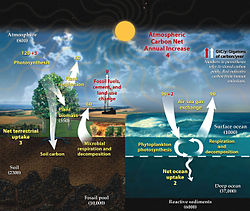Carbon sink
A carbon sink is a natural or artificial reservoir that stores carbon-containing chemical compounds for a long period. Carbon sinks absorb more carbon than they release.
A forest, ocean, or other natural environments produce surplus carbon. Carbon sinks are very important in our environment. They can be natural or man-made. Soil, ocean, forest and the atmosphere all store carbon and this carbon moves in a continuous cycle. The largest carbon sinks become swamps, bogs, and eventually coal measures.
In the regular carbon cycle, CO2 comes from the atmosphere and then is taken by plants and uses it in the process of photosynthesis.
Carbon Sink Media
Carbon sinks (green bars on the right) remove carbon from the atmosphere, whereas carbon sources (greenhouse gas emissions) (grey bars on the left) add them. Since the 1850s, there are more carbon sources than sinks and therefore the carbon dioxide in Earth's atmosphere is rising.
This diagram of the fast carbon cycle shows the movement of carbon between land, atmosphere, soil and oceans in billions of tons of carbon per year. Yellow numbers are natural fluxes, red are human contributions in billions of tons of carbon per year. White numbers indicate stored carbon.
Mjøstårnet, one of the tallest timber buildings, at its opening 2019


